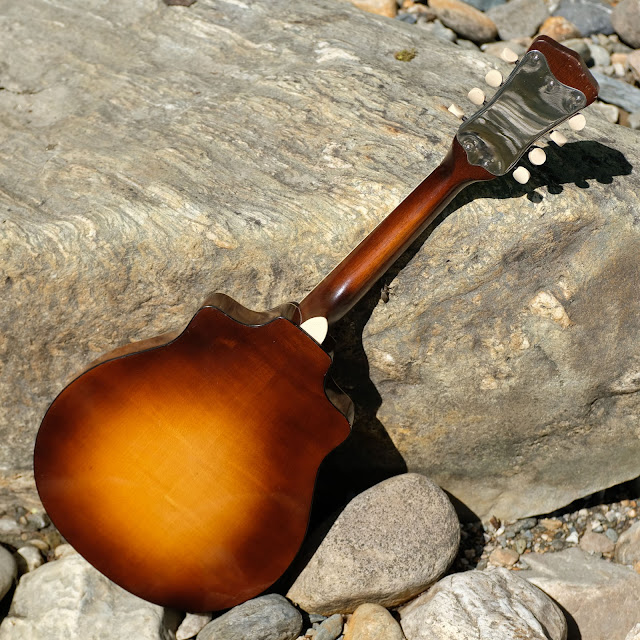1920s Harmony-made Shutt-style Carved-Top Mandolin
This is the cleanest Shutt-style mandolin that I've seen. The last one through the shop, though, was admittedly a bit beat-up. Like that other one, this one is screaming-loud and punchy and -- though you can't quite hear it in the soundclip -- sweet and round at the edges of its sound. It's certainly a professional-sounding and quality-materials instrument.
I worked on this one for a customer and it got a neck reset, fret level/dress, and fitting of a new Cumberland acoustic bridge. The neck joints on these instruments aren't the best and during steam-out the bottom of the heel split as it snagged on a crumpled-up old shim that was in the joint while my clamp was applying pressure to the heel. That's happened to me before, but it sure is annoying when it does. It didn't look like the instrument had work done to it in the past and the joint was loosey-goosey, which made it even more frustrating.
On the other side of work, the mando is now healthy and holding-pat with the customer's requested 40w-11 strings. That's a gauge heavier than I'd suggest, but the neck itself remains straight which is amazing for a '20s Harmony product. They usually can't take more than 10s and this is a long-scale instrument, too. When you're tuning-up for the first time, these mandos make all sorts of terrifying, terrible creaks and groans as the top settles back into position. This is because the tops are carved like a violin or Gibson-style mandolin but they are unbraced. This is both the strength of the design (as the top generates a ton of drive and volume as well as a mellow tone) but also its major weakness, too.
After work on these you have to wait a couple days with the instrument at tension before making final setup adjustments. I have a feeling I'm going to have to trim the (already-trimmed) bridge down a bit more before shipping it home as I can visibly see that both the endblock area and neckblock areas have compressed a little under tension (as in these areas are not exactly 90-degrees to the top anymore) as it's sat for the last 24 hours at pitch. At the time I took the soundclip, though, it seems to have stabilized. I think this compression is mostly due to the top not having any extra length-wise stabilization via bracing.
All that said and done, these are super-de-duper boxes and rare as heck, too. The tops, as said, are carved spruce and the back and sides are flamed, solid maple. The neck is mahogany and the fretboard is "ebonized" maple. The new bridge is ebony, however, and adjustable.
Specs are: 13 7/8" scale, 1 3/16" nut width, 31/32" string spacing at the nut, 1 17/32" spacing at the bridge, hair-under 1/16" action at the 12th fret (with a straight neck), 10 1/4" lower bout, 6 3/4" upper bout, and 1 3/8" side depth.
The nut is original and bone and the headstock veneer is ebonized maple as well.
The pickguard is awesome, no? I moved it just a hair so it'd clear the bridge and shimmed it up underneath near the fretboard extension to make sure it remains off of the top. It was damping a lot of sound when it was resting on its felt pad near the bridge.
I have foam under the tailpiece cover to damp string overtones behind the bridge.
Nice maple, right? In a cool twist, the instrument has black back binding and white top binding.
The tuners look much like ordinary tuner plates under this cover, though they're set in a recessed chamber. Harmony almost never fixed them to the headstock with screws under the coverplate, however, so I installed some inside to keep the tuners from moving around as they do without them.
It also has its original case.

















Comments